Small - Medium, Orange-Salmon-Pink Underwings: usually under 65mm

|
verrilliana; Verrill's Underwing;
45-60mm
Closed, subtriangular subreniform spot is large and
light in colour. Light patch runs from subreniform
diagonally (inwardly) to costa. There is a dark area on the basal side of
the am line, and there are light patches between postmedian and subterminal lines
distinguishing this species. Note orange hw fringe.
|

| Catocala ophelia;
Ophelia Underwing: 52mm:
Fw dark grey, am/pm lines are
relatively smooth except for two jagged spikes in pm
near apex. Considerable brown shading outside
subterminal line. Hw deep red, black
median band constricted in
center and terminating before im. Black
submarginal border is quite broad near apex. White fringe
heavily checked.
|

|
faustina;
58 mm
Forewing markings are relatively weak on almost uniform drab grey-brown ground colour.
The two middle "teeth" in the forewing postmedial line are relatively short.
The hindwing inner band is narrow and truncated well before the inner margin.
Black extenssions into white hindwing fringe continue as thin lines along veins.
|

|
faustina cleopatra;
58 mm; Head and thorax dark bluish grey; abdomen brownish grey.
Primaries dark bluish grey. Transverse lines, reniform and sub-reniform indistinct with
some yellowish brown shading on upper surface.
Orange to pinkish hw with relatively narrow bands, fringe (unbroken) white on exterior margin, grey near abdomen.
|

|
californica;
65-68mm.
Fws dark, gritty. Markings indistinct. Dark, large reniform spot; am/pm lines indistinct.
Subterminal line inwardly lined with light scales. Hw fringe white, checked in black halfway to outer edge,
black lines on veins extending through fringe. Some orange bleeding at apex. Hw black median line terminates
well before inner margin.
|
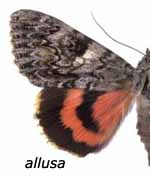
|
faustina allusa.
White interior outline of terminal line is typical of this species
and two jagged upper "teeth" of postmedial line are typical of most
poplar feeders. There is also a dark bar a few mm up from inner
margin of the forewing. Subreniform spot and area interior and above tend to be lighter. Coastal
|

| Catocala hermia;
Hermia Underwing: 58-68mm; pinkish:
Fw almost uniform, grey-brown or clay coloured; thin, yet contrasting lines.
Distinct large double reniform spot. Large concolourous subrenifrom spot usually open.
Hw pinkish red, relatively even, narrow black bands. Inner black band ends before im.
Fringe white, checked, pink/red "bleeding" along outer band, near apex.
|

| #8817 briseis;
Briseis Underwing;
60-70mm.
Fws predominantly mottled dark-grey-brown with some lighter areas 1) between pm and subterminal lines,
2) at base of am and pm lines along
i. m., and 3) over subreniform spot running diagonally toward costa.
Pm lines lack greatly elongated, sharly pointed "teeth" near apex.
Hw fringe white, unbroken; inner black band (fairly even) reaches i. m..
Tim Dyson image.
|

|
irene; Irene's Underwing;
65-75mm.
Fw grey brown, darker upper half basal area, around reniform spot, indistinct arc near apex.
Sbrnfrm spot lighter, open into pm area.
Hw median black band pointed before reaching im. Outer band scalloped near a. a..
Probably southeast; poplars, willows
|

| ** 8821
semirelicta; Semirelict Underwing;
65-75mm
FW ground colour is whitish with dark lines and shadings.
Diffuse dark bar runs from center of basal area to outer margin a
few mm above anal angle. Note regular dentation of st line.
Hw inner black bar usually terminates well before
inner margin. The form "atala" has a forewing that is uniformly grey.
Unijuga is usually larger and has less contrasting black lines.
Inner black bar on unijuga usually reaches inner margin.
|

| Catocala grotiana;
Grote's Underwing: 70-80mm:
The white outlines outside the postmedial and inside the subterminal lines make this species stand out.
The hindwing inner black band is even and relatively thin and terminates well before the inner margin.
The fringe is heavily checked and charcoal grey along the inner margin.
Hindwings can be orange or red.
|

| Catocala junctura;
Joined Underwing; 67-85mm.
Fw is usually dark brownish-gray to evenly powdered
blue-grey w/o significant markings. Doubled reniform spot
often obscure. Thin, slightly darker am and pm
lines run from costa to im, not widely
spaced at im. Hw salmon/ orange-pink, narrow inner black band
turns in sharply, does not meet dark-haired im.
|

| ** 8805 unijuga;
Once-married; 70-90mm.
Fairly wide black inner band (almost reaching inner margin) in
hw and very distinctive patterning in fw. Meskei tend to
have narrower band and dustier (less distinct) looking forewing.
Semirelicta tend to have inner bands terminating well before
inner margins.
Note very white fringe on both forewings & hindwings.
Carroll Rudy image.
|

| ** 8805 unijuga form agatha;
Once-married; 70-90mm.
Fairly wide black inner band (almost reaching inner margin) in
hw and very distinctive patterning in fw. Meskei tend to
have narrower band and dustier (less distinct) looking forewing.
Semirelicta tend to have inner bands terminating well before
inner margins.
Note very white fringe on both forewings & hindwings.
Carroll Rudy image.
|
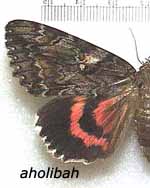
| aholibah;
80-90mm: Fw is mix of grey and brown, with preponderance of brown in subterminal area.
Double reniform spot has diffuse brown outline of inner oval. Subreniform spot is small,
distinctly outlined in black,
light coloured and does not connect to pm line. Upper two teeth of pm line are elongate
and are followed by relatively smooth line til next tooth below the subreniform spot.
Hindwing salmon or pinkish.
|

| Catocala frederici;
Frederic's Underwing: 40-52mm:
Fw blotchy yellow-brown, faint lines. Double am line has large central lobe.
Subrenifrom spot closed and pale.
Submarginal area orangey-yellow.
Hw yellow-orange, with outer black band broken, followed by flattened dot.
Thin inner black band angles almost 90 degree, truncated
well before im. Apex, large yellow area.
|

| Catocala chelidonia;
45-50mm. Fw fuscous grey. Reniform, subreniform spots concolourous, with
srf closed, sometimes lighter and brown. Pm line thin, distinct, two upper teeth slightly produced.
Hw orangish. Black median band swollen near cell, angles 90 d toward, not to
im. Fringes off-white opp. orange, grey
opp. outer band. Some orange near apex inside thin, distinct sm line.
|

| Catocala chelidonia uniforma;
45-50mm. This subspecies has uniform gray forewings with substantially reduced
hoary mottling. The antemedial and postmedial forewing lines vary from inconspicuous
to very distinct, but weaken toward inner margin.
Known from mountains
of southeastern Arizona and southwestern New Mexico.
|

| Catocala benjamini;
50 mm. Catocala benjamini reportedly flies as the nominate susbspecies in Arizona, Nevada, southern California and southern Utah.
Catocala benjamini mayhewi flies in southern California. Catocala benjamini jumpi
flies in the Kofa Mountains of Arizona. Catocala benjamini ute flies in
southeastern Utah in the Balaneed Rock Area at elevations around 1610 m.
|

| Catocala caesia;
55mm. Fw blotchy blue-grey-brown with some lighter areas. Double am line dark & thick/diffuse. Distinct pm line, evenly dentate,
traced outwardly with thin white.
Reniform spot pale brown. Small subrectangular subreniform spot almost pure white, indented on inward side.
Hw bright yellow, unchecked yellow fringes. Inner black band
relatively thin, angles acutely toward im, bluntly truncated.
|

| Catocala desdemona;
55-70mm. Fw gc is light mottled grey with greenish blue cast. Double reniform spot
brown. Subreniform spot large, lighter brown, closed; tail extends to pm line.
Upper pml teeth moderately produced, next two teeth, not at all. Next produced, thick,
rounded, distinct inward loop below.
Hw ib turns 90 toward im. Ob broken; large orange apical area.
|

| Catocala ilia zoe male;
65mm. Fw gc light grey, considerable brown scaling. Double reniform spot has brown center, thinly outlined in black, widely outlined in white,
then thinly outlined in black. Subreniform spot indented on inner & outer sides, just above its tailed extension,
which may/may not be open.
Am line black, distinct, pointed, triangular shaped indentation just above im. Pml darker along upper half.
|

| Catocala piatrix dionyza;
68-84mm. Fw has light-colored band/bar extending from large, pale brown subreniform spot along am line to costa.
There is usually relatively dark area between reniform spot and pm line, wing veins tend to be dark and distinct there.
Hw fringe lightly barred, lighter than deeper orange on rest of wing.
|

| Catocala neogama euphemia;
78-90mm:
Fw ground colour charcoal grey, often with bluish tinge. Am line thick,
dark along costa, extends in three more narrowly lined lobes, upper two notched,
toward, but not reaching midpoint of im. Pm line has two upper teeth elongated,
followed by much short tooth, longer tooth along extended line of subreniform spot.
|

| ** 8833 Catocala violenta
Violent Underwing (70-80mm): Two elongated, well-defined spikes high in the postmedial line
extend to subterminal line. Next tooth is very short. There is considerable brown shading on
the forewing between the pme and st lines.
Subreniform spot is light with light bar extending obliquely to
the costa.
|

| Catocala jessica;
Jessica Underwing: 75mm: Fw is bluish grey with some brown scaling. Am line is irregular, meets i m almost at midpoint.
Pm line has one upper tooth produced, second is much less so. Third is little more than a sharp point
on smooth curve to fourth tooth, somewhat produced over opening of large subreniform spot.
Reniform spot is double and dark in darker region of median area.
|

| Catocala electilis;
Fw dark grey. Black pm line thin but distinct; two upper teeth not greatly produced.
Reniform spot dark brown; large, pork-chop shaped subreniform spot lighter brown
extends to pm line. Brown shading in subterminal area.
Hw salmon (orange to red).
|
Midsized Orange-Salmon-Red-Scarlet Underwings: Wingspans: 50-72mm
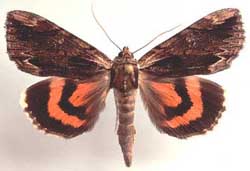
| ** 8857 Catocala ultronia;
Ultronia Underwing, wingspan: 50-63mm.
Fws typically gray-brown, with a distinct and very
dark inner margin and characteristic light brown patch, underscored
by very dark arc, near wingtip.
Underwings can be yellow to orange to salmon.
|
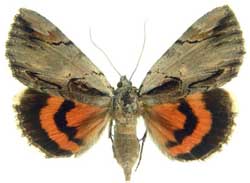
| ** 8857 Catocala ultronia form lucinda;
Ultronia Underwing, wingspan: 50-63mm.
In form lucinda most of the forewing
is bright grey. On all forms there is
extensive orange-salmon colouration on hw ventral surface,
and there is a dark discal lunule.
|
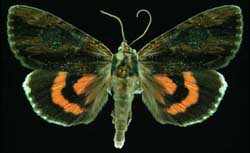
| Catocala ultronia,
form nigrescens, the Ultronia Underwing, wingspan: 50-63mm.
In the melanic form nigrescens, the dorsal forewing is very dark.
Even darker subapical arc, basal dash and dash near anal angle are still visible.
Dark basal hairs on hindwing.
Harold J. Vermes slide, used with permission from his son.
|
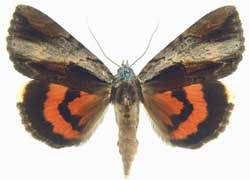
|
In form celia there is a wide, light grey band separating a dark region along inner margin and
a dark patch near the apex.
The ventral surface of forewings of all forms has a generous suffusion
of orange-salmon scales in the lower half of the median area.
|
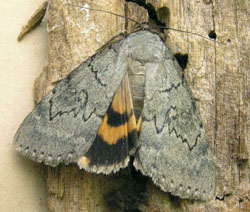 |
** 8779 serena
Serene Underwing; WI/JOD.
The head and collar and abdomen are brown while the thorax is grey.
The am and pm lines are thin but very dark and distinct on an
otherwise drab, almost uniformly olive-grey forewing.
The black marginal band of the lower wings is indented at the center,
and the relatively narrow, deep yellow median band parallels this
indentation. Basal hairs are brown.
Catocala serena courtesy of
Carroll Rudy.
|
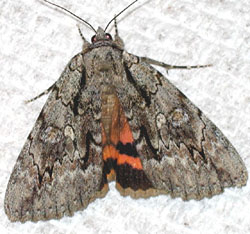
| #8778
Catocala habilis;
wingspan: 55-65mm
Large "M" on thorax,
"pork chop" shaped, light coloured subreniform spot very
dark in constriction at juncture with pml. Pml narrow, dark, distinct, outwardly lined with
narrow suffusion of white scales, followed by broader band of brown
scales, then broader suffusion of white scales up to
very regular dentation of sbtml line.
Significant "bleeding" of yellow-orange-salmon scales into
hw fringes.
Large reniform spot has brown center, faintly edged in black, then
white, then black again.
|

| #8795 Catocala palaeogama
; wingspan: 60-70mm.
Subreniform spot closed, does not approach pm line,
is smaller than in C. habilis.
All forms have characteristic orange, heavily barred fringe to
apex, and irregular bands on hws. Hw basal median
area heavily suffused with dark brown to black scales.
Dark bar in outer half of median area,
paralleling i. m. halfway between
i. m. and light, closed subreniform spot.
Joe Garris photo.
|

| #8795 Catocala palaeogama
form phalanga; wingspan: 60-70mm.
In this form, fw basal area and subterminal
area are very dark against a much lighter background.
Dark bar in the outer half of the
median area, paralleling the inner margin halfway between
the inner margin and the light, closed subreniform spot is especially
evident.
|

| ** 8770
Catocala innubens;
Betrothed; 55-72mm.
Forewing is mottled with white, grey and brown, and
subrenifrom spot tends to be lighter in colour, although it is
sometimes obscured by an indistinct blackish bar which runs from
middle of basal/thorax connection to just below much lighter
apex at outer margin.
Jim Vargo image. |

| ** 8770
Catocala innubens form scintillans;
Betrothed; 55-72mm.
In form scintillans most of the basal area (all but lower third) and all of the median area of the forewing is dark reddish brown.
The area outside the pm line is grey.
|

| ** 8851
Catocala coccinata;
Scarlet; 57-70mm:
Diffuse basal,anal dashes on otherwise light
grey, mottled fw. Hw fringe white (often with some salmon scaling),
heavily checked.
"Tooth" just below pair of very elongated "teeth" is
much reduced, quite rounded, usually allowing considerable room
for lighter patch of scales. Dark bar crosses thorax.
Reniform spot: light, often with greenish cast.
|

| Catocala delilah; 58-65;
The forewing is gray-brown with prominent black antemedial
and postmedial lines. The hindwing is yellow-orange, with a narrow
inner black band which reaches the inner margin. There is a large
yellow spot at the apex, and the fringe is faintly barred.
The underside of the wings is deep yellow with black bands.
|

| ** 8840
Catocala illecta;
Magdalen Underwing, wingspan: 60-70mm
The forewing pattern and colouration is much like that of the pink-underwinged concumbens,
pale grey with faint black lines.
Hindwings are very clear, light yellow-orange, and the irregular inner black band
terminates well before the inner margin.
|

| ** 8772 Catocala consors WO;
Consort, wingspan: 70mm plus:
Fw has irregular am, pm narrow black lines. Dark patch
outside reniform, subreniform spots. There is a diffuse, wide, greyish-white band in the subterminal area, running from the costa to the inner margin.
Orange-yellow hindwing pm band tends to be narrow,
irregularly zigzagged. Sometimes band is wider and slightly less
irregular.
|

| ** 8801
Catocala ilia; Ilia;
wingspan: 65-82mm.
Several different forms,
most have characteristic white area in and around
reniform spot. Diffuse dark arc running from this
spot to just below apex. Subreniform spot squarish, concave inner and outer edges
and elongated constriction connecting it to pml.
White dots near fw om in character
with the overall "contrasting" appearance.
|

| ** 8801
Catocala ilia; Ilia;
form conspicua
In this form the entire reniform spot is heavily suffused with white scaling on
an otherwise darker ground colour. Hence the form name "conspicua".
|

| ** 8801
Catocala ilia; Ilia;
form satanas
In this melanic form the entire forewing, including the reniform spot is very dark. Hence the form name "satanas".
The dark basal streak is still evident on this form.
|

| ** 8801
Catocala ilia; Ilia;
form normani
In this semi-melanic form the entire forewing, excluding the reniform spot, is relatively dark.
The brownish, kidney-shaped center of the reniform spot is outlined in white.
The basal streak and subapical arc are still visible.
|

| ** 8771 Catocala piatrix ;
Penitent, wingspan: 68-84mm
The forewing has a light-colored band/bar extending from the
subreniform spot along the am line to the costa.
The fringe of the hindwing is lightly barred and is lighter in color
than the deeper orange on the rest of wing.
|

| ** 8798 Catocala neogama;
wingspan 70-85mm.
Brown head, thorax, larger size as compared to
C. palaeogama. Neogama tend to be slightly smaller
than subnata, have darker grey brown fws with more
pronounced markings. Examination of hind tibia needed
for id. Neogama's: flattened,
unevenly, sparsely spined; subnata's: cylindrical,
spines dense, uniform in distribution.
|

| ** 8797 Catocala subnata;
Youthful Underwing: 75-90mm.
Fws greyish white with blue-grey and light brown scales,
usually with hws brighter
yellow than those of neogama. Neogama usually
have basal dash; absent in male subnata, but present in females.
Magnification of hind tibia needed for id:
subnata: cylindrical hind tibia;
neogama: compressed or flattened hind tibia.
subnata: ventral surface of tibia densely covered with evenly
distributed spines;
neogama: ventral surface of tibia sparsely covered.
|

| Catocala nebulosa;
Moths have prominent dark brown upper-half-basal patch that extends
to and ends at antemedial line. Apical area also tends to be
brown, much darker than median area but not as dark as basal patch.
The anal angle also has the darker brown scaling.
The pm line is distinct near costa and inner margin, but becomes
weak between the two. It meets inner margin in relative close
proximity to am line.
Closed subreniform spot is large and connects to the
pm line via a thin line.
|
|